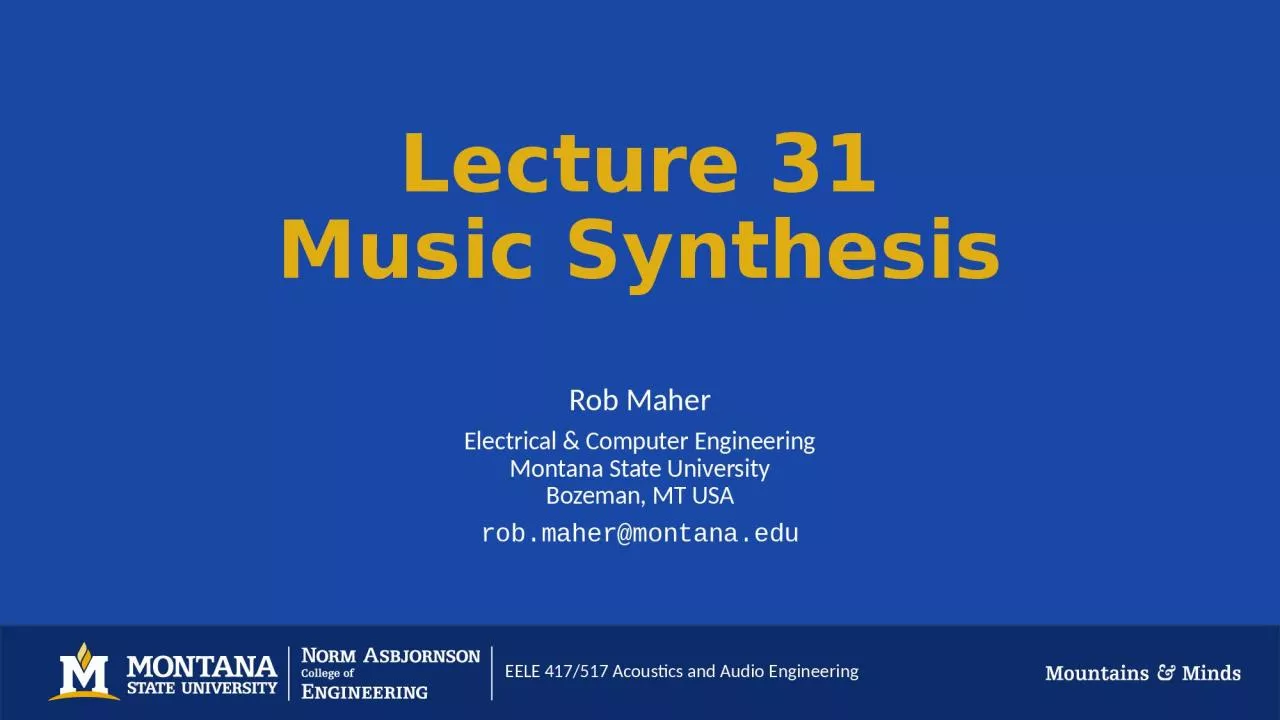

Rob Maher Electrical amp Computer Engineering Montana State University Bozeman MT USA robmahermontanaedu Objective and Subjective Frequency Pitch Sound level Loudness ID: 1017740
Download Presentation The PPT/PDF document "Lecture 31 Music Synthesis" is the property of its rightful owner. Permission is granted to download and print the materials on this web site for personal, non-commercial use only, and to display it on your personal computer provided you do not modify the materials and that you retain all copyright notices contained in the materials. By downloading content from our website, you accept the terms of this agreement.
1. Lecture 31Music SynthesisRob MaherElectrical & Computer EngineeringMontana State UniversityBozeman, MT USArob.maher@montana.edu
2. Objective and SubjectiveFrequency PitchSound level LoudnessRepetition rate TempoSource Geometry LocalizationSpectrum Timbre
3. TimbreThe relative spectral energy at different frequencies is perceived as a distinct tone color, or timbre (pronounced as either tam--burr or tim-burr)Timbre: The combination of qualities of a sound that distinguishes it from other sounds of the same pitch and volumeInterest in electronically simulating desired timbres
4. Some HistoryThree distinct directions of synthesis development:Coded Performance (e.g., player piano)Direct Performance (e.g, keyboard or gestural interface)Musique Concrete (e.g., tape music)
5. ~1900: The TelharmoniumThaddeus Cahill, inventorUsed a series of geared electrical generators to create harmonicsBefore amplifiers: direct power transmission into homes and businesses via telephone wiresKeyboard and potentiometer controlOccupied 30 box cars and weighed 200 tons!
6.
7. ~1920: The ThereminLeon Theremin, inventorHigh frequency fixed oscillator (10 MHz)High frequency variable oscillator adjusted by capacitance (10 MHz)Capacitance altered by hands moved near antennae:Antenna to adjust frequencyAntenna to adjust volumeSound is audible “beat” frequency between fixed oscillator and variable oscillator
8. https://youtu.be/pSzTPGlNa5U
9. ~1928: The Ondes MartenotMaurice Martenot, inventorKeyboard instrument with resistance wirehttps://youtu.be/f4phKWMaOr0
10. ~1928: The Trautonium and MixturtrautoniumFredrich Trautwein, inventorNeon tube oscillator with resistance wire controlTouch-sensitive actionElectric filters for “formants”https://youtu.be/-tQQEChMq1A
11. ~1930: The Hammond OrganLaurens Hammond, inventorFrequencies derived from 60Hz power line frequencyTone wheels with “bumps” pass magnetic pickupsOnly 91 sine wave frequencies: all partials are equal-temperedFrequencies 1 : 2 : 2.9966 : 4 : 5.0397 : etc.Uses tremolo to eliminate mistuned and “bland” soundLeslie Loudspeaker – spinning for Doppler vibrato
12.
13. Hammond FrequenciesFrequency F (Hz) = M * T * RFor A4: 20 * 16 * (88 / 64) = 440HzFor C#8 = 4,434Hz: 20 * 192 * (74/64) = 4440Hz91 Hammond tone wheels12 tonewheels of 2 teeth12 tonewheels of 4 teeth12 tonewheels of 8 teeth12 tonewheels of 16 teeth12 tonewheels of 32 teeth12 tonewheels of 64 teeth12 tonewheels of 128 teeth7 tonewheels of 192 teeth M – Motor speed, 20 revs/second (1200 rpm) T – Number of teeth on the tone wheel R – The gear ratio. This is equal to the number of teeth on the driving gear / number of teeth on driven gear.
14. Leslie LoudspeakerRotating horns for high frequencies, rotating spinning drum for low frequencieshttps://youtu.be/F4XSZ1haPk4
15. ~1948: Musique ConcretePierre Schaeffer, originatorUse of sound as “found objects”Everyday sounds used as musicFirst used phonograph records for sound assembly, then tape recorders
16. ~1955: The RCA SynthesizerVacuum tube oscillatorsControlled by roll of punched paper tapeFrequency and amplitude controlsAudio output to a disc cutter
17. ~1965: Voltage Controlled SynthesizersRobert MoogARPEMSElectrocompBuchlaInitially monophonic and modular, with patch cordsLater keyboard controlled and portable
18. Wendy Carlos
19. Voltage Controlled modulesVCO – voltage controlled oscillatorVCA – voltage controlled amplifierVCF – voltage controlled filterEG – envelope generatorLFO – low frequency oscillatorSequencer – memory unit triggered by a clock
20. https://www.montana.edu/rmaher/eele217_fl18/soundfiles/Preston_spacerace.wav
21. ~1970: Computer MusicWavetable synthesis (fixed waveform)Additive synthesisModulation techniques (AM, FM, Ring modulation, waveshaping)Subtractive synthesis
22. ~1980-present:Computers as musical instrumentsMusical Instrument Digital Interface (MIDI)Software synthesisReal time recording direct-to-diskReal time mixing